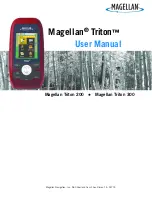
SF-2050 User Guide - Rev. E
Global Positioning System (GPS) geometrically, there
can only be one point in space, which is the correct
distance from each of four known points.
GPS
measures
the distance from a point to at least four satellites from
a constellation of 24 NAVSTAR satellites orbiting the
earth at a very high
altitude
. These distances are used
to calculate the point’s
position
.
GMT see Greenwich Mean Time.
GPS see
Global Positioning System
.
GPS time a measure of time.
GPS
time is based on
UTC
, but does not add periodic ‘leap seconds’ to
correct for changes in the earth’s period of rotation. As
of September 2002
GPS
time is 13 seconds ahead of
UTC
.
Greenwich Mean Time (
GMT
) the local time of the 0°
meridian
passing through Greenwich, England.
HAE see
altitude
, and
ellipsoid
.
JPL Jet Propulsion Laboratory.
Kbps kilobits per second.
L-Band the group of radio frequencies
extending from approximately 400MHz to
approximately 1600MHz. The
GPS
carrier
frequencies L1 (1575.4MHz) and L2 (1227.6
MHz) are in the
L-Band
range.
L1 carrier frequency the primary
L-Band
carrier used
by
GPS
satellites to transmit satellite data. The
frequency is 1575.42MHz. It is modulated by
C/A code
,
P-code or Y-code, and a 50 bit/second navigation
message.
Glossary-57
Summary of Contents for GPS Products
Page 2: ......
Page 12: ......
Page 20: ...SF 2050 User Guide Rev E Figure 2 SF 2050 Front View Figure 3 SF 2050M Only Back View 2 18...
Page 41: ......
Page 43: ...SF 2050 User Guide Rev E Satellite Based Augmentation System Signals WAAS EGNOS StarFire A 41...
Page 51: ...SF 2050 User Guide Figure C1 StarFire Network C 49...
Page 55: ......









































